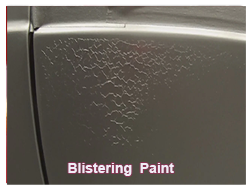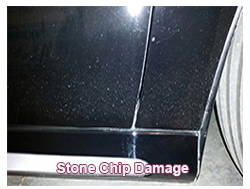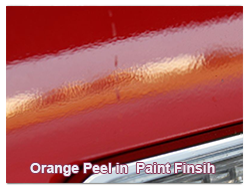
BLISTER: Describes a localised bubble on the surface of a tire, usually caused by a separation between plies or between surface rubber and a ply.
BLISTERING:  Describes the formation of bubbles on a painted surface.
Describes the formation of bubbles on a painted surface.
BLOOMING: Describes the formation of an undesired thin surface film or a milky white haze or mist on paintwork, caused when moisture is trapped in the wet film if paint is applied during humid or cold conditions.
CHALKING:Describes the appearance of a white powder on a painted surface as it weathers and ages.
CRATERING: Describes the formation of holes in the paint coat due to surface contaminants.
CRAZING: Describes a large number of fine cracks in the paint surface, resembling crow's feet.
CREASE: Describes a wrinkle or ridge in metal as a result of design or accident damage.
CREEPAGE: Describes the slow spreading of rust under the paint, which usually first appears as a blister and later flaking.
ETCHING: Describes a situation where a painted surface shows signs of roughening or disintegration, either on small patches or over a wide area, caused by an excess of bird droppings, soap deposits or even industrial fallout.
FADING: Describes a loss of brightness or colour in a paint finish that occurs over time.
FISHEYE: Describes a small pit that can form in the finish coat of paint, usually due to insufficient or improper cleaning of the old coat.
FLAKE: Describes the action of paint when it starts to come off the surface in small, thin sections
FLAKING: Describes the tendency of paint to lift away from the surface because of poor adhesion.
HEAVY FILM BUILD: Describes excessive thickness of paint coating.
INTER-COAT ADHESION FAILURE: Describes a situation caused by excessive bake time of coatings in spray paint, resulting in too hard a finish, poor flatting of coats, providing poor keying of coats or exceptionally low film thickness.
ORANGE PEEL: Describes a rough paint surface resembling the skin of an orange, caused by paint spray failing to flow together.
OVERTHIN: Describes the mistake of adding too much thinner to paint
PINHOLING: Describes the tiny bubbles often grouped in a paint finish caused by trapped solvents, moisture or air released from the film.
POOR OPACITY: Describes a paint fault in which the colour of underlying coats or fillers remains visible through the topcoat, a phenomenon usually caused by insufficient paint thickness application or over thinning the paint.
RUN: Describes a form of paint run usually caused by spraying too close to the panel surface, inducing an excessive and unsightly build-up of paint.
SAGGING: Describes a situation caused by various professional mishaps where a band of paint runs down the side of a vertical area of the body.
SHRINKAGE: Describes the coverage reduction of automotive paint as it dries. All automotive paints are liable to shrink, exposing scratches that have not been adequately filled, exposing imperfections as the paint shrinks into them.
SOLIDS: Describes the ingredients of the paint that remain on the surface after the solvents have evaporated.
SOLVENT POPPING: Describes a type of blister caused by trapped solvents that can form on a paint film.
SPLIT SPRAY: Describes a situation where a paint spray gun has been incorrectly set up and whose spray pattern is heavy at the top and bottom while narrow in the middle.
STONE CHIP DAMAGE: Describes paintwork defect caused when the driver runs over gravel or small sharp stones
SURFACE TACK: Describes a condition that occurs after filler is applied to a panel surface, where the material will not cure in certain places, caused by improper mixing of the filler paste with the hardener.
SURFACE-TYPE FILTER: Describes an air and cartridge-type oil filter design where waste particles accumulate on its surface.
SWELLING: Describes a paint fault condition that occurs when an excessively rapid thinner is used in a paint allowing soft paint to sink into blemishes on the surface.
SWIRL MARKS: Describes a circular pattern produced by an orbital sander on a painted surface that can only be removed by hand sanding using fine-grit sandpaper. If not removed, the marks will remain visible through the respray coat.
TARNISH: Describesa form of paintwork discolouration caused by the formation of oxide, sulphide, or similar corrosion catalysts.
TOUCH-DRY:
WEATHERING: Describes the gradual change in paint caused by exposure to the elements, causing a mixture of chemical decomposition and physical disintegration.
 Describes the condition that occurs immediately after a car body has been resprayed and the paint has dried, but the coat has not yet hardened sufficiently to be polished.
Describes the condition that occurs immediately after a car body has been resprayed and the paint has dried, but the coat has not yet hardened sufficiently to be polished.


